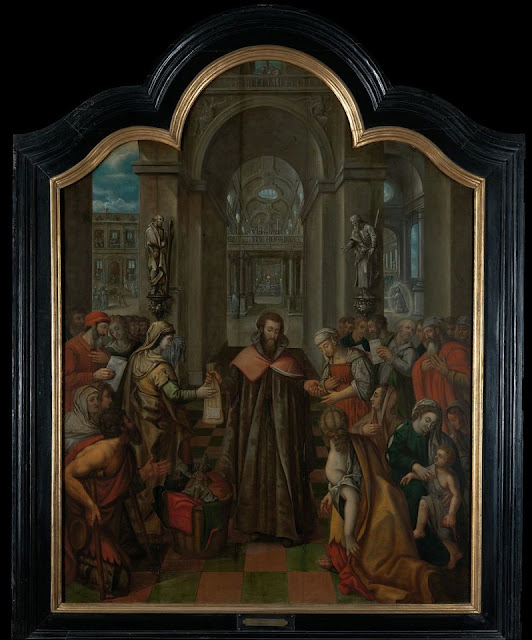Irene Caesar, b. 1963
Susanna and the Elders, c. 2015
Triptych: left
Photograph
Susanna and the Elders. A fair Hebrew wife named Susanna was falsely accused by lecherous voyeurs. As she bathes in her garden, having sent her attendants away, two lustful elders secretly observe the lovely Susanna. When she makes her way back to her house, they accost her, threatening to claim that she was meeting a young man in the garden unless she agrees to have sex with them.
Irene Caesar, b. 1963
Susanna and the Elders, c. 2015
Triptych: center
Photograph
She refuses to be blackmailed and is arrested and about to be put to death for promiscuity when a young man named Daniel interrupts the proceedings, shouting that the elders should be questioned to prevent the death of an innocent. After being separated, the two men are questioned about details of what they saw, but disagree about the tree under which Susanna supposedly met her lover. In the Greek text, the names of the trees cited by the elders form puns with the sentence given by Daniel. The first says they were under a mastic, and Daniel says that an angel stands ready to cuthim in two. The second says they were under an evergreen oak tree, and Daniel says that an angel stands ready to saw him in two. The great difference in size between a mastic and an oak makes the elders' lie plain to all the observers. The false accusers are put to death, and virtue triumphs. More on Susanna and the Elders
Irene Caesar, b. 1963
Susanna and the Elders, c. 2015
Triptych: right
Photograph
Irene Caesar, Ph.D., (born 10 September 1963 in St. Petersburg, Russia) is a Russian-American conceptual artist and philosopher. She became a professional artist in 1988, and came to prominence in Russia in the early 1990s, with articles about her in major Russian newspapers of that time. As a way of questioning modern art, Caesar created a series of photographic portraits of some well-known critics, film directors, and artists, including Arthur Danto, Vitaly Komar, Alexander Melamid, Slava Tsukerman, Vadim Perelman, which she produced as absurd role-games. Caesar participated in the dissident movement in Russia, was invited by Marina Salye to make a speech at the Founding Conference of the Free Democratic Party of Russia during the 1991 Putsch, and produced the series of portraits of important dissidents. Critics emphasized that the uniqueness of Caesar’s creativity consists in the fact that, for the first time in the history of art, a woman – from a woman’s point of view -- gives an assessment of such a wide scope of human ideas via her art. More Irene Caesar
Please visit my other blogs: Art
Collector, Mythology, Marine
Art, Portrait of a Lady, The
Orientalist, and The Canals of
Venice, And visit my Boards
on Pinterest
Images are copyright of their
respective owners, assignees or others. Some Images may be subject to copyright
I don't own any of these images -
credit is always given when due unless it is unknown to me. if I post your
images without your permission, please tell me.
I do not sell art, art prints, framed
posters or reproductions. Ads are shown only to compensate the hosting
expenses.
If you enjoyed this post, please share
with friends and family.
Thank you for visiting my blog and also
for liking its posts and pages.
















